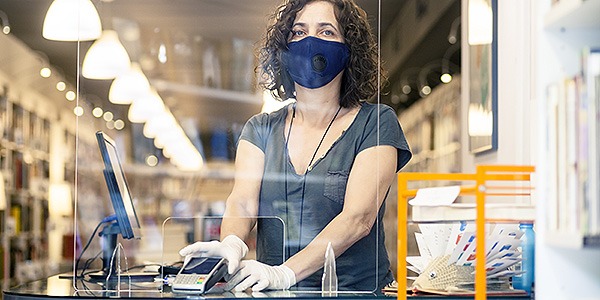
The COVID-19 worldwide pandemic is a devastating and highly contagious disease that is affecting us all, particularly people with disability.
The key principles of prioritising public health and safety to protect people against infection, compliance with public health guidelines, working with governments and public health authorities, and changing our behaviours such as social distancing and hygiene measures are being practiced at every opportunity.
The Building Code of Australia provides definitive requirements within part D3.7 Hearing Augmentation for when the public is screened from service providers/ assistants
(a) A hearing augmentation system must be provided where an inbuilt amplification system, other than one used only
for emergency warning, is installed—
(i) in a room in a Class 9b building; or
(ii) in an auditorium, conference room, meeting room or room for judicatory purposes; or
(iii) at any ticket office, teller’s booth, reception area or the like, where the public is screened from the service provider.
The provision of PPE (personal protective equipment) especially masks or face shields in some regions is now strongly recommended or mandatory.
Viruses are transmitted between people, usually when a person is exposed to the secretions of an infected person. The current route of transmission of the coronavirus is unclear, but past experience has shown that exposure to the body fluid that an infected person coughs or sprays or shaking hands with an infected person leads to infection.
Australian businesses have also risen to the challenge and are adapting to the new COVIDNORM and it is becoming clear that many of these changes are here to stay. Plexiglass sneeze guards have been around for many years but are now commonplace in a large portion of service-based businesses, but these sneeze guards have brought about a new challenge to communicate with many people on both sides of the screen unable to hear.
In doing so businesses unwittingly are now in breach of a number of sections of the Disability Discrimination Act as follows.
The ability to see a smile can really help.
55% of communication is visual. Traditional masks block faces and prevent our ability to see facial expressions and emotions, catch visual cues, and communicate.
Audio frequency induction loop system (AFILS)
An amplified transmitting sound system that is connected to a loop cable that generates a magnetic field, which is utilized by a person wearing a hearing aid with a built-in T-switch.
For people in the community who are hearing impaired, masks with transparent screens have also been introduced to aid in lip reading, however, these masks do not benefit all people.
To help, Hearing Loop Australia have sourced a plug and play solution that has speakers and microphones on both sides of the screen that incorporates hearing augmentation technology. This solution will help any business wanting to improve customer service for people with and without hearing loss. This Speech Transfer Package is a flexible system that is well suited to counters, reception desks, retail outlets and many other applications.
This new solution is available to help people with and without hearing loss on both sides of the counter communicate better. The speakers benefit people without hearing impairment whilst the hearing augmentation technology allows people with T-switches that are built into hearing aids to connect directly to the amplification system.
More Information Available Here
https://www.hearingloop.com.au/shop/packages/counter-sound-transfer-package/
Signage design from Braille Sign Supplies
Again the Building Code of Australia addresses the required signage to be provided along with Hearing Augmentation
D3.6 Signage
In a building required to be accessible—
(b) signage including the international symbol for deafness in accordance with AS 1428.1 must be provided within a room containing a hearing augmentation system identifying—
(i) the type of hearing augmentation; and
(ii) the area covered within the room; and
(iii) if receivers are being used and where the receivers can be obtained;
These adult-sized fabric masks feature a 150mm x 70mm clear shield in the front of the mask that allows members of the deaf to communicate with the aid of lip reading
The mask measures 220mm x 150mm and includes adjustable earloops for comfort to reduce the incidence of Coronavirus and COVID 19 Viruses that are transmitted between when people exposed to the secretions of the infected person
These child-sized fabric masks feature a 60mm x 30mm clear shield in the front of the mask that allows members of the deaf to communicate with the aid of lip reading
The mask measures 190mm x 110mm and includes adjustable earloops for comfort to reduce the incidence of Coronavirus and COVID 19 Viruses that are transmitted between when people exposed to the secretions of the infected person
Masks available from EvacuLife which is part of the Equal Access Group